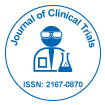
Journal of Clinical Trials
Open Access
ISSN: 2167-0870

ISSN: 2167-0870
Perspective - (2025)Volume 15, Issue 3
Chemoprevention refers to the use of natural or synthetic compounds to reduce the risk of cancer development or progression. This preventive approach aims to interfere with the molecular pathways involved in carcinogenesis before malignancy becomes clinically evident. Over the past few decades, a variety of agents have been evaluated for their potential to prevent cancer through preclinical models, observational studies and randomized clinical trials.
Chemoprevention trials are specifically designed to test whether such agents can reduce the incidence, delay the onset, or suppress the recurrence of cancer in high-risk populations. These studies are essential to translating laboratory findings into clinical interventions. Designing, conducting and interpreting chemoprevention trials, however, involves a range of scientific, ethical and logistical complexities.
Principles of chemoprevention
Chemoprevention is based on the understanding that cancer is a multistep process involving genetic mutations, cellular dysregulation and immune escape. Intervention at the early or intermediate stages of this process may prevent malignant transformation. Agents used in chemoprevention are generally classified into three categories:
• Primary prevention agents: Used in individuals with no prior history of cancer but at increased risk due to genetic, environmental, or lifestyle factors.
• Secondary prevention agents: Used to prevent the progression of precancerous lesions or early-stage disease.
• Tertiary prevention agents: Used to prevent cancer recurrence in patients who have undergone treatment.
Commonly studied agents include dietary supplements (e.g., vitamins, minerals), pharmaceuticals (e.g., selective estrogen receptor modulators) and natural compounds (e.g., curcumin, green tea polyphenols).
Phases of chemoprevention trials
Chemoprevention trials typically follow a multi-phase structure, similar to therapeutic drug development:
• Phase I trials assess safety, dosing and pharmacokinetics in healthy volunteers or at-risk individuals.
• Phase II trials explore biological activity using intermediate endpoints such as biomarkers of carcinogenesis, histologic changes, or molecular alterations.
• Phase III trials are large-scale, randomized, placebo-controlled studies that evaluate the agent’s effect on cancer incidence or progression in target populations.
These trials require long durations and large sample sizes, as cancer development is a time-dependent process. The use of validated biomarkers and surrogate endpoints is important in early-phase trials to predict efficacy without waiting for cancer occurrence.
Challenges in conducting chemoprevention trials
Several challenges hinder the implementation and success of chemoprevention trials:
Participant recruitment and retention: As these trials often involve healthy or asymptomatic individuals, motivating long-term participation is difficult. Concerns about side effects, trial duration and perceived lack of benefit can reduce adherence.
Long duration and cost: The slow progression of most cancers means that trials may need to run for years to detect meaningful differences in incidence. This results in significant financial and logistical demands.
Risk-benefit balance: Preventive agents are often administered to individuals who may never develop cancer. Even mild adverse effects can outweigh perceived benefits, making safety a major concern.
Selection of endpoints: Cancer incidence as a primary endpoint requires large sample sizes and extended follow-up. The use of validated intermediate biomarkers is essential, yet identifying such markers remains a scientific hurdle.
Emerging approaches and future perspectives
Recent advances in molecular biology and genomics have opened new opportunities for precision chemoprevention. Biomarker-based risk stratification allows the selection of individuals most likely to benefit from specific agents. Additionally, the integration of omics technologies can identify novel targets and mechanisms for prevention.
Adaptive trial designs, which allow for modifications based on interim findings, can improve trial efficiency. Moreover, the use of digital health technologies to monitor adherence, side effects and behavioral changes may enhance data collection and participant engagement.
Combination approaches, where multiple agents with complementary mechanisms are used together, are also under exploration. Such strategies may reduce the required dose of individual compounds, potentially improving safety and efficacy.
Chemoprevention trials serve as an important research framework to test interventions aimed at reducing cancer burden before disease onset. Despite numerous challenges, this field continues to evolve through advances in molecular understanding, risk prediction and clinical trial design. Future trials will benefit from more precise selection of participants, validated endpoints and improved methods to assess efficacy and safety over time. Continued exploration of chemo preventive strategies holds potential to reduce cancer incidence and improve population health outcomes.
Citation: Olivia J (2025). Advancing Cancer Prevention Through Chemoprevention Trials: A Clinical Perspective. J Clin Trials. 15:588.
Received: 02-May-2025, Manuscript No. JCTR-25-37518; Editor assigned: 05-May-2025, Pre QC No. JCTR-25-37518 (PQ); Reviewed: 20-May-2025, QC No. JCTR-25-37518; Revised: 28-May-2025, Manuscript No. JCTR-25-37518 (R); Published: 05-Jun-2025 , DOI: 10.35248/2167-0870.25.15.588
Copyright: © 2025 Olivia J. This is an open-access article distributed under the terms of the Creative Commons Attribution License, which permits unrestricted use, distribution and reproduction in any medium, provided the original author and source are credited.